Start with 1/2 cup uncooked rice per person, using a 1:1 ratio for short-grain or 1:1.5 for long-grain varieties. You'll want to adjust your water levels based on your climate – use less in humid areas and more in dry conditions. Choose a dark-colored 5-quart pot to accommodate rice expansion and maximize heat absorption. Don't forget to rinse your rice beforehand for better texture and preheat your solar oven for 30 minutes. Remember to rotate your oven every half hour to track the sun's movement. These foundational steps will reveal the secrets to perfectly portioned solar-cooked rice.
Measuring Rice For Solar Cooking
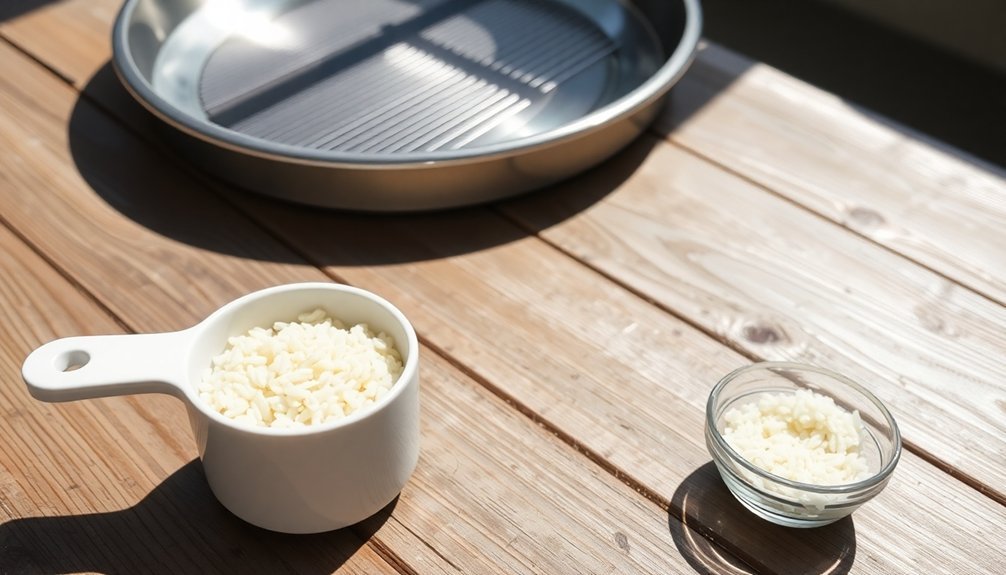
Mastering the right measurements is essential for perfectly cooked rice in your solar oven. You'll need to establish the correct rice-to-water ratio, which typically ranges from 1:1 to 1:1.5, depending on your specific rice variety. For instance, if you're cooking one cup of rice, you'll need between one and one and a half cups of water.
When measuring rice for your solar cooker, consider the type you're using. Short-grain varieties like Japanese or Thai rice generally produce better results. If you're using jasmine or basmati rice, you may need to adjust your water measurements slightly. Long-grain rice typically requires more water and additional cooking time.
Your solar cooker's efficiency and the ambient temperature will affect your measurements. If you're using a solar cooker that retains moisture well, you'll want to reduce the water content slightly. Solar heating process takes longer than conventional cooking methods, so plan accordingly.
Use a black pot with a tight-fitting lid to maximize heat absorption and retain moisture. Remember to place your cooking vessel on a level surface to guarantee even cooking. Don't open the cooker frequently, as this will release valuable heat and extend cooking time.
Adjust Water Based On Climate
The success of your solar-cooked rice depends heavily on adapting water amounts to your local climate. Start with a basic 1:1 ratio of rice to water, then adjust based on your specific conditions. In hot, dry climates, you'll need to add slightly more water, while cooler, humid environments require less to prevent mushy results.
Your solar cooker type also influences water requirements. If you're using a parabolic cooker, you might need less water due to its intense heat concentration. Box-style cookers typically need more water since they heat more slowly and evenly. Traditional cooking calls for 1 cup of water per 1/4 cup of rice, as shown in the Ottawa rice recipe. You'll want to add half to one extra portion of water compared to conventional cooking methods.
Weather conditions play a significant role in your water adjustments. On windy days, secure your cooker with weights or a tripod to maintain steady cooking temperatures. If you're dealing with partial clouds or high altitudes, increase your water ratio slightly and expect longer cooking times.
Keep monitoring your rice during cooking – you can always add more water if it's too dry or remove the lid briefly if it's too wet.
Perfect Portions Per Person
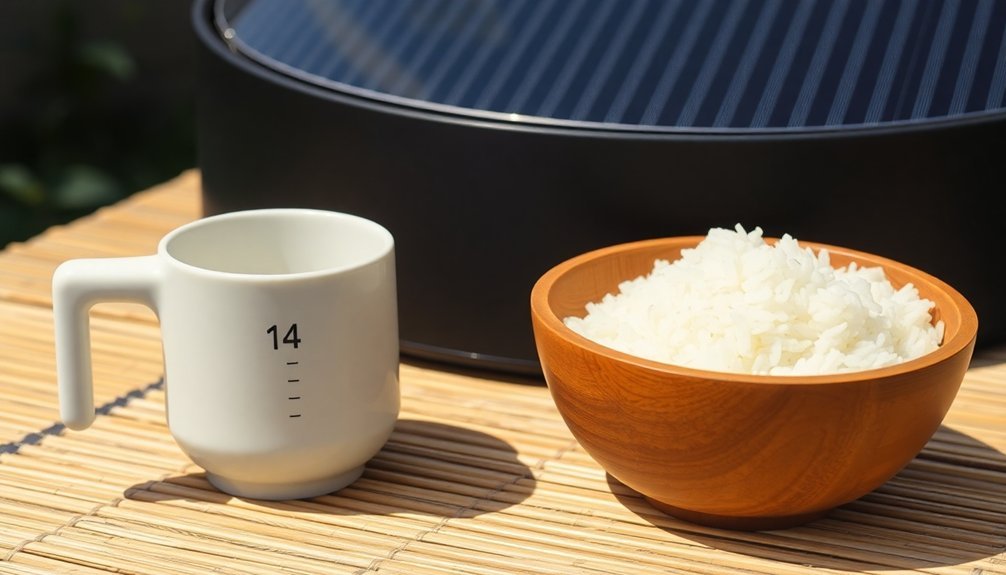
Planning out portions up to your needs helps verify perfectly cooked rice for everyone at your solar-powered meal.
When using a solar oven, you'll want to account for both the type of rice you're using and your cooking timeline to determine proper portions.
For short-grain rice, measure 1/2 cup of uncooked rice per person, which will require about 5/8 cup of water. If you're cooking long-grain rice, stick to the same 1/2 cup portion per person but increase the water to 1 cup per serving.
You'll need to guarantee there's at least an inch of water above your rice regardless of the amount you're cooking. Rinsing your rice will lead to better texture and overall quality in your solar-cooked dish.
Remember that cooking times vary greatly based on your solar cooker type. If you're using a parabolic cooker, you can prepare multiple portions in 20-30 minutes, while box or panel cookers require 3-6 hours.
It's best to start cooking between 10:00 a.m. and 2:00 p.m. when sun intensity is highest. For larger groups, you might want to cook in batches using a parabolic cooker, or prepare all portions at once in a box cooker if you have adequate time and sunlight.
Pot Size And Rice Expansion
After determining your portions, selecting the right pot becomes your next essential consideration. You'll want to choose a pot that can accommodate rice's considerable expansion during cooking while preventing any overflow. For solar cooking, a 5-quart casserole dish or black enamel turkey roaster offers ample space for larger meals.
When cooking rice in your solar oven, you'll need to account for slightly different water absorption rates compared to conventional cooking. You may need to add extra water due to the slower heating process. Choose dark-colored or black enamel pots, as they'll absorb sunlight more effectively and maintain consistent temperatures throughout the cooking process.
Your pot's thermal mass plays a vital role in cooking success. Thicker pots with good heat retention properties will help maintain steady temperatures and guarantee even cooking.
If you're preparing multiple dishes, you can double-stack smaller pots on a leveling tray. Remember that while your solar oven's interior might be narrow, it can still accommodate various pot sizes. The shape of your pot won't greatly impact cooking performance, so focus more on choosing the right capacity for your rice portions.
Solar Cooking Time Management
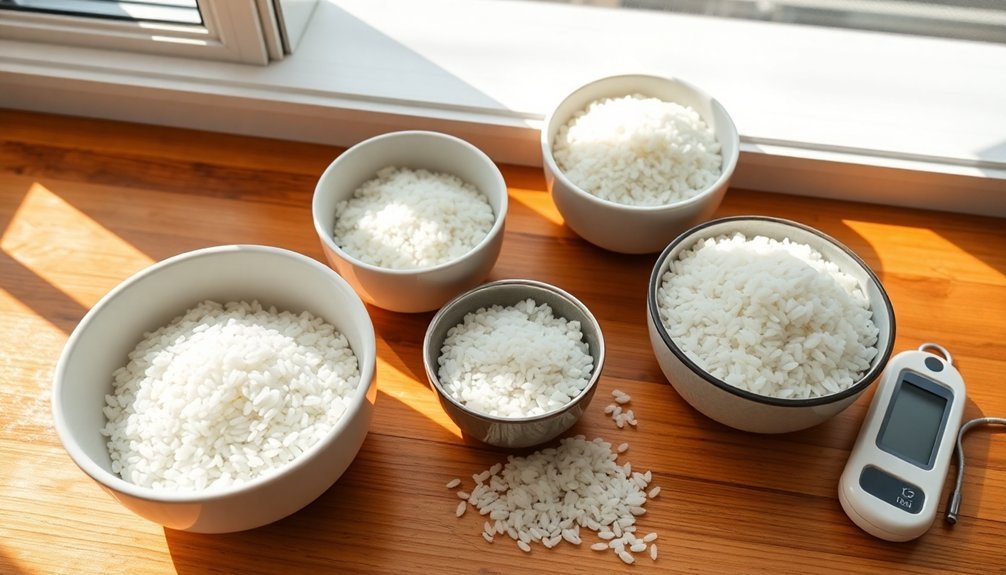
Successfully managing time when cooking rice in a solar oven starts with proper preheating and sun positioning. You'll need to preheat your solar oven for at least 30 minutes while you prepare your ingredients. During this time, make sure your oven is positioned in direct sunlight with no shadows blocking its exposure.
For best results, you'll want to maintain temperatures above 200 degrees Fahrenheit, though your solar oven can reach up to 400 degrees in ideal conditions. Cooking times typically range from 1 to 1.5 hours, but weather conditions will greatly impact this duration. You'll need to rotate your oven every 30 minutes to follow the sun's path and maintain consistent heat.
- Check for small holes forming on the rice's surface – this indicates water absorption
- Monitor the cooking process regularly to make sure proper liquid absorption
- Allow the cooked rice to rest for 10 minutes after cooking
Remember that cloudy days require longer cooking times, so you might want to use thermal mass like a brick to improve heat retention.
Keep adjusting the oven's angle based on your latitude and the sun's position throughout the cooking process.
Frequently Asked Questions
Can Different Rice Varieties Be Mixed When Cooking in a Solar Oven?
You can mix different rice varieties in a solar oven, but it's not recommended. If you must, choose types with similar cooking times and water needs to avoid uneven results. Test small batches first.
How Does Altitude Affect Rice Texture When Using Solar Ovens?
At higher altitudes, you'll notice your rice takes longer to cook in your solar oven due to lower boiling points. You'll need to adjust cooking times and water ratios to achieve the tender texture you're seeking.
What's the Best Way to Store Leftover Solar-Cooked Rice?
Let your rice cool completely, then store it in an airtight glass container. You'll want to refrigerate it within two hours of cooking. It'll stay fresh for 3-5 days when properly stored.
Will Adding Spices or Seasonings Change the Solar Cooking Time?
No, you won't need to adjust your solar cooking time when adding spices or seasonings. They'll enhance the flavor of your rice but don't affect the physical cooking process or required duration in your solar cooker.
Can Rice Be Reheated in a Solar Oven on Cloudy Days?
Yes, you can reheat rice in a solar oven on cloudy days, though it'll take longer. You'll still get enough heat from diffused light, but make sure to plan for extended heating times of 30-45 minutes.
In Summary
You'll find solar cooking rice becomes second nature once you've mastered these portion control basics. Remember to measure carefully, adjust your water ratio based on your local climate, and allow for proper expansion in your cooking pot. Stick to recommended serving sizes, and you'll avoid waste while ensuring perfectly cooked rice every time. Keep track of cooking duration as the sun's intensity changes throughout the day.


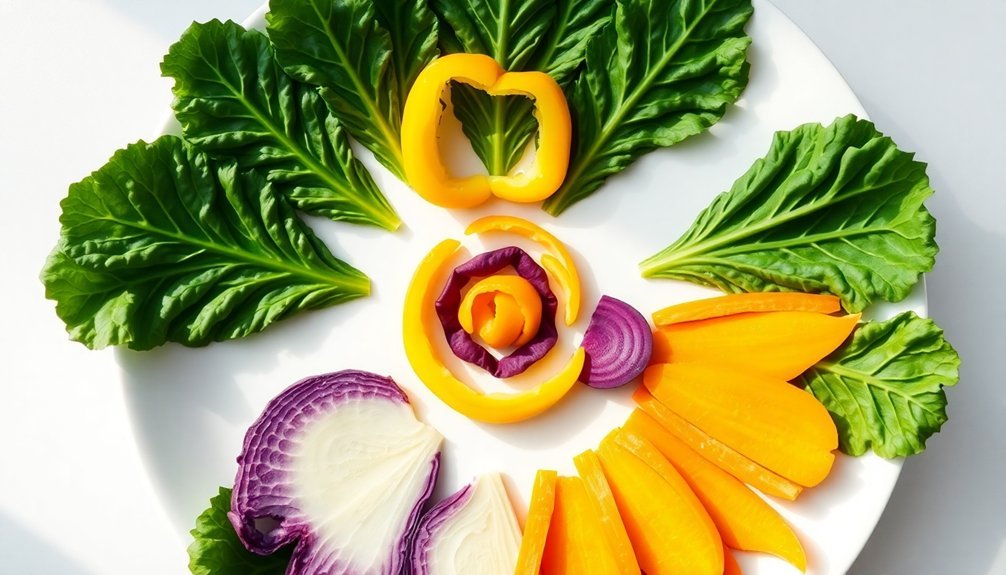

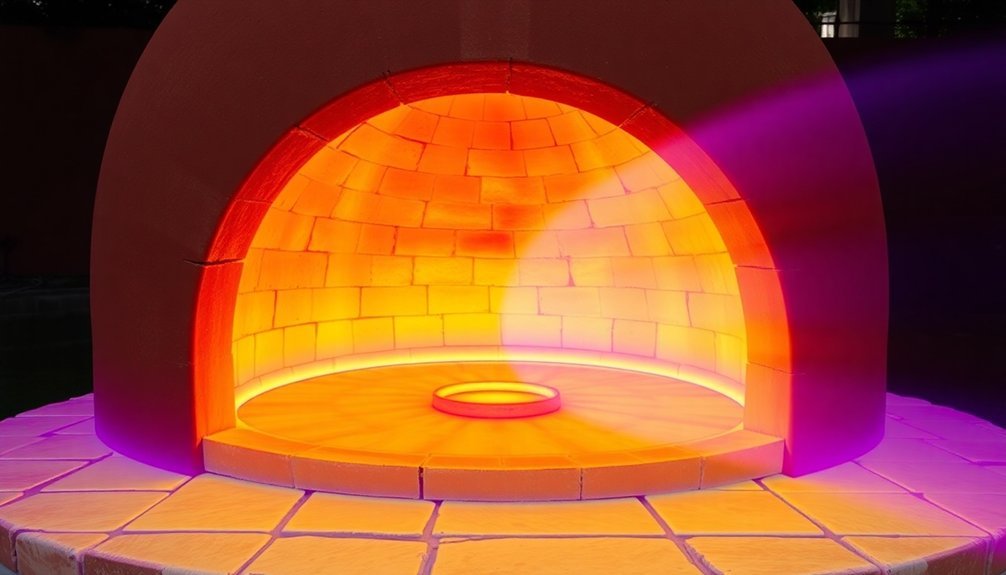
Leave a Reply